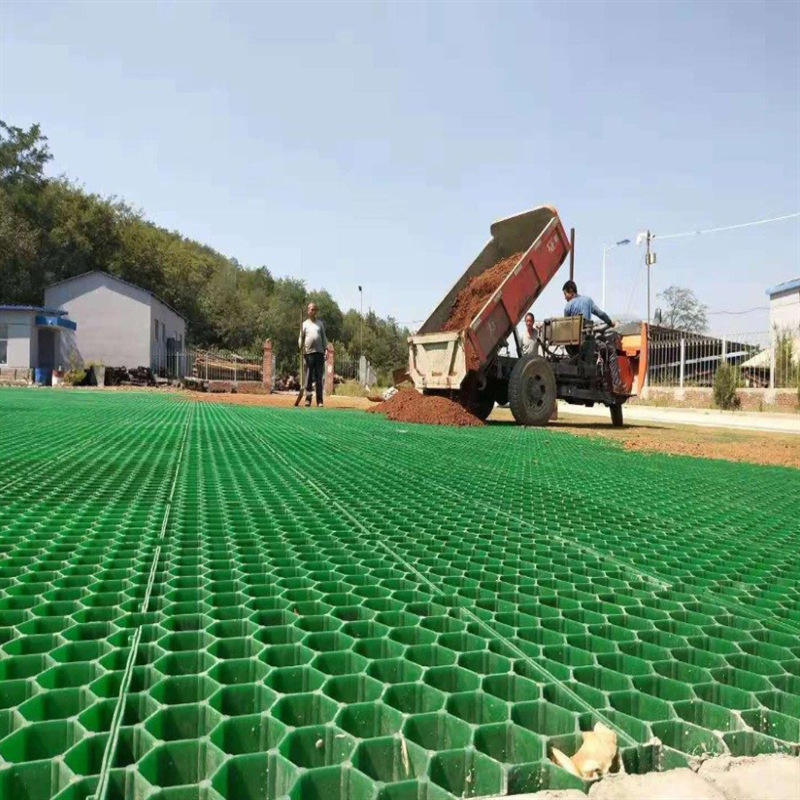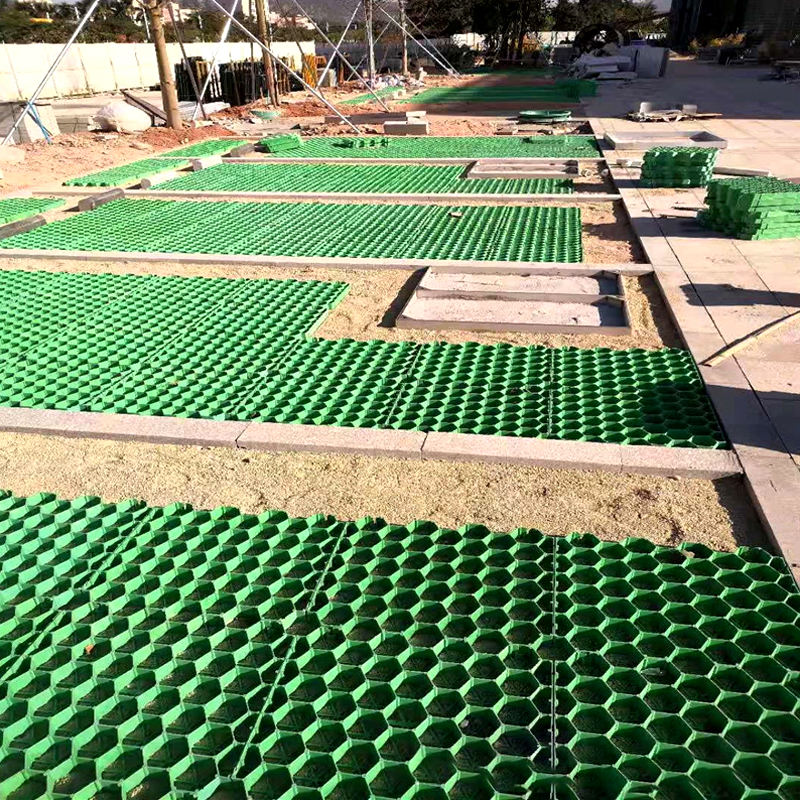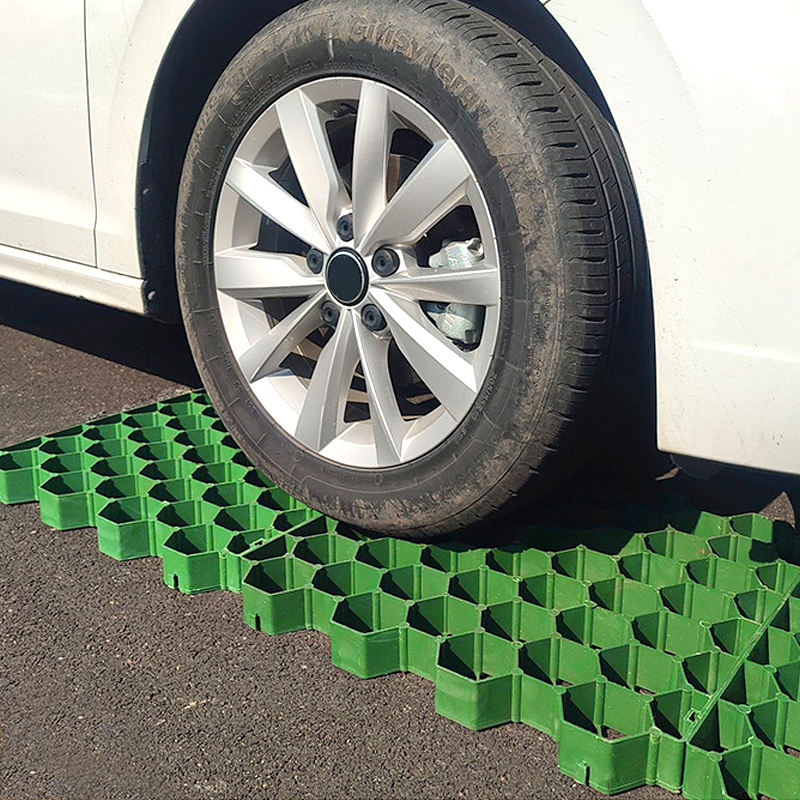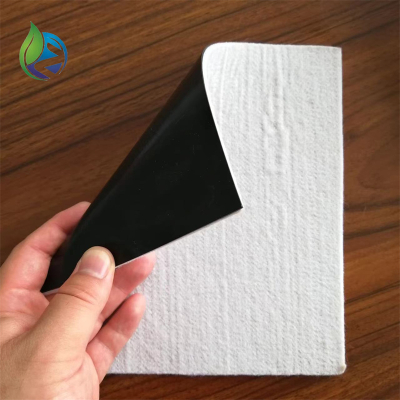Permeable grass-planting grids alleviate urban waterlogging
Permeable Grass Pavers Plastic: Alleviating Urban Waterlogging
Urbanization has made modern life more convenient and prosperous, but it’s stuck with a major headache: urban waterlogging. Every rainy season, tons of cities worldwide deal with gridlocked traffic, damaged infrastructure, and even risks to daily life thanks to heavy rain. The main issue? Cities lean too hard on impermeable materials—concrete, asphalt, you name it—when building or paving. These hard surfaces stop rainwater from soaking into the ground, so water runs off fast and overwhelms drains. That’s where permeable paving comes in, and grass pavers plastic is a practical, eco-friendly pick that gets the job done without ignoring the planet.
The Causes and Impacts of Urban Waterlogging
Urban waterlogging doesn’t just pop up out of nowhere. It’s a mix of things. First, as cities grow, they cover natural permeable areas—lawns, wetlands, soil. Traditional city building focuses on roads, buildings, parking lots; over 70% of some city centers are paved with impermeable stuff. When heavy rain hits, these surfaces can’t absorb water, so it flows everywhere and pools in low spots.
Another thing: old, undersized drainage systems make it worse. Many older cities built drains based on past rainfall. Now, with more urban sprawl and extreme weather from climate change, those systems can’t handle the extra runoff. Storms are more frequent and intense, so drains already stretched thin are now way over capacity.
The impacts are far-reaching. Let’s be honest—traffic jams are the first hassle. Flooded roads stop buses, cars, bikes, making commutes late and slowing emergency help. For residents, water seeps into basements, wrecking furniture, electronics, personal gear. In bad cases, it damages building structures. Infrastructure like power lines, gas pipes, phone networks fail if submerged, cutting essential services. Standing water breeds mosquitoes and bacteria, too—total health risk. For the environment, runoff carries trash, oil, chemicals into rivers and lakes, polluting water and hurting aquatic life. But here’s the good news: grass pavers plastic fixes the root cause by letting the ground soak up water again.
How Permeable Grass Pavers Plastic Works
To get why grass pavers plastic works for waterlogging, just look at its design. Unlike traditional impermeable paving, it has a grid-like structure that blends hard paving’s stability with natural soil’s ability to absorb water.
The main part is connected cells—empty spaces that take up most of the surface. When installed right (we stress this—we’ve done dozens of projects, and bad installation ruins even the best pavers), you pack those cells with nutrient-dense soil and grass seeds suited to the local climate. As grass grows, roots twist through soil and plastic grid, making a stable yet permeable surface. Rain falls, and instead of running off, it soaks through gaps between grass blades and grid. Then it seeps into the soil below, refilling groundwater instead of flooding drains.
The plastic material is key. It’s tough enough for cars and foot traffic, so the surface stays stable with regular use. It’s not like concrete that cracks at the first sign of pressure—grass pavers plastic has a little flex. It handles small ground shifts without breaking. That flex keeps it permeable, too—unlike traditional paving, the grid doesn’t pack down over time. Plus, plastic resists rust, sun damage, extreme weather, so it lasts years even in harsh cities. By mimicking nature’s water cycle, grass pavers plastic cuts runoff and lowers waterlogging risk.
Core Advantages of Grass Pavers Plastic
Grass pavers plastic doesn’t just fix waterlogging—it has other perks that make it great for city projects. These benefits fit cities’ practical needs and sustainable goals.
First, drainage is off the charts. The grid has 30-50% empty space, so rainwater soaks in fast. This cuts runoff and refills groundwater—critical for soil moisture and city plants. Traditional concrete or asphalt barely soaks up anything, so runoff spikes and groundwater drops.
One more perk: it holds serious weight. A lot of people think permeable surfaces are flimsy, but good grass pavers plastic handles cars, light trucks, even heavy construction vehicles—if you prep the base right. No shortcuts here. We’ve had jobs where skipping the gravel base led to pavers sinking in six months. The plastic grid spreads weight evenly, so it doesn’t deform and stays stable for years. That means it works for driveways, parking lots, even city roads.
It’s eco-friendly too. Most grass pavers plastic uses recycled plastic, cutting down on waste. And since it grows grass, it improves air quality—grass soaks up CO2 and releases oxygen. The green surface cools cities, too. Grass and soil absorb less heat than concrete or asphalt, easing the urban heat island effect. That makes cities more comfortable and cuts cooling energy use.
Lastly, it’s easy to install and maintain. Plastic is light, so moving and laying it is easier than heavy concrete pavers—saves time and labor. Installation is simple: prep a compacted base, lay pavers in a pattern, fill cells with soil and seeds, water until grass grows. Maintenance? A breeze. Pull weeds now and then, trim grass, clear debris from the grid so water flows. Unlike concrete, which needs constant crack repairs, grass pavers plastic is durable and low-upkeep. All these perks make it a cost-effective, sustainable fix for waterlogging.
Application Scenarios of Grass Pavers Plastic in Urban Settings
Grass pavers plastic is versatile—its mix of permeability, strength, and greenery works in lots of city spaces.
Parking lots are the most common use. Stores, offices, neighborhoods need big lots, usually paved with impermeable materials. Grass pavers plastic cuts runoff and adds green space. It holds parked cars, and grass between grids makes the area look nicer. A lot of cities already do this, turning drab concrete lots into “green parking zones” that fight waterlogging and spruce up the city.
City roads and sidewalks are another win. Sidewalks, bike lanes, road shoulders can use grass pavers plastic to soak up more water. Besides cutting runoff, these green surfaces are nicer for walkers and cyclists—cooler, more natural. For road shoulders, it stops erosion, protecting the road and keeping the area stable. We’ve seen it on rural-urban fringe roads where erosion is bad, and it holds up surprisingly well.
Public parks benefit too. Paths, plazas, event areas need stable surfaces for foot traffic. Grass pavers plastic is a permeable alternative to concrete or stone. It lets rainwater soak in, helping park plants grow without extra watering. Keeps the ecosystem balanced.
Roof gardens and vertical greening projects use it too. Flat-roof buildings can use lightweight grass pavers plastic for roof gardens. These soak up rainwater and insulate the building, cutting energy costs. Plastic is light, so it doesn’t add too much weight—architects love that. For vertical green walls, it acts as a base for plants, adding greenery and fighting waterlogging.
Slopes and riverbanks are another use case. Many cities have rivers, lakes, slopes prone to erosion. Grass pavers plastic holds soil in place while letting water soak through. Grass roots grow deep, making a natural erosion barrier, and the plastic grid adds stability. This protects coastal areas and riverbanks from flooding and erosion—another win for waterlogging. In all these spots, grass pavers plastic proves it’s a flexible, effective solution for sustainable cities.
Installation and Maintenance Tips for Grass Pavers Plastic
To get the most out of grass pavers plastic, install it right and do basic maintenance. It’s designed to be easy, but follow these rules—we’ve seen jobs succeed (and fail) because of this.
Installation Steps
Site prep is non-negotiable. Don’t skimp here—lazy base work ruins projects. Before laying grass pavers plastic, clear debris, plants, topsoil to reach stable ground. Level it and tamp down firm so it doesn’t settle later. For high-traffic areas like parking lots, add 10-15 cm of crushed stone or gravel—boosts strength and drainage. Trust me, that gravel makes all the difference.
Laying pavers is straightforward. Arrange grass pavers plastic in a consistent pattern, line up grids so water flows evenly. Interlock them or use stakes to keep them from moving. Leave small gaps between pavers—helps with expansion in hot weather. Don’t lay them too tight, or they’ll warp.
Fill the grids next. Pack cells with topsoil and organic matter to help grass grow. Don’t pack soil too tight—needs to touch pavers but let water through. Sow grass seeds suited to your climate: fescue for northern areas, Bermuda for southern.
Watering is key. After seeding, water well and keep moist until grass is fully grown—usually 2-4 weeks, depending on weather. Keep people off—young grass and loose soil get damaged easy. A simple barrier or signs work.
Maintenance Guidelines
Regular cleaning keeps it permeable. Clear leaves, twigs, trash from grass pavers plastic. Clogged grids stop water flow, so sweep or rinse often—especially after storms. A leaf blower is perfect for quick cleanups; no need for fancy equipment.
Trim grass regularly—keep it 5-8 cm tall. Too long, and it blocks grid gaps, reducing drainage. Fertilize once or twice a year with slow-release fertilizer—keeps grass thick, stable, and looking good. Avoid harsh fertilizers that run off into nearby water.
Check for damage now and then. Look for cracks, warping, shifting in grass pavers plastic. Replace damaged ones right away—water seeping under broken pavers causes settlement. For high-traffic areas, check the base too—compaction or erosion hurts load-bearing. A quick inspection every six months is enough.
Weed control is simple. Dense grass usually keeps weeds out, but pull stragglers from grid gaps. Use organic methods—vinegar-based killers work for small patches. Don’t damage grass or the environment.
Do these steps, and grass pavers plastic will soak up water and work well for decades—long-term waterlogging relief.
The Future of Grass Pavers Plastic in Urban Waterlogging Mitigation
Cities worldwide face climate change and more urbanization, so they need sustainable water management. Grass pavers plastic is perfectly placed to help—new improvements and government support are making it more popular.
Manufacturers are tweaking grass pavers plastic to be better. They’re using 100% recycled plastic, making them hold more weight, and boosting UV resistance for longer life. Some new designs have better drainage channels—we’ve tested them, and permeability is way better.
Government rules help too. Many countries have rules or incentives for sustainable building. Some cities require new projects to use permeable paving; others offer tax breaks for eco-friendly picks like grass pavers plastic. These policies push cities to adopt permeable solutions and raise awareness about waterlogging.
Grass pavers plastic could pair with smart city systems. Who knows, soon we might see grass pavers plastic with built-in sensors that send alerts when drainage slows down. That data helps schedule maintenance and improve water management in real time. Pairing with rainwater collection systems is smart too—reuse collected water for irrigation.
People care more about the environment now, so they want greener cities. Grass pavers plastic fits—functional and good-looking, creating green spaces that improve life. From neighborhoods to business districts, using it is becoming a sign of sustainable development. It’s only a matter of time before grass pavers plastic becomes standard city infrastructure. It fixes waterlogging, is eco-friendly, and makes cities nicer to live in. As tech improves and policies back it, more cities will use it—building climate-resilient, green cities.
Conclusion
Urban waterlogging is a big, messy problem that needs creative, sustainable solutions. Grass pavers plastic works—it blends permeability, strength, and eco-friendliness seamlessly. By letting rainwater soak into the ground, cutting runoff, and refilling groundwater, it fixes the root cause. It also adds greenery, cools cities, and stops erosion.
Grass pavers plastic works in parking lots, roads, parks, roof gardens, slopes—you name it. It’s easy to install, low-maintenance, and long-lasting. That’s why city planners, architects, developers love it. As tech improves and governments support it, it will play a bigger role in sustainable building.
With climate change and urbanization worsening, we need strong, eco-friendly infrastructure more than ever. Grass pavers plastic is a simple solution cities can use now to build better, more sustainable places. By using this innovative material, cities reduce waterlogging, improve life for residents, and move toward a greener future.







